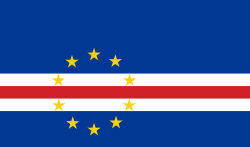| Part of a series on the |
| Culture of Cape Verde |
|---|
 |
| History |
| People |
| Languages |
| Cuisine |
| Religion |
| Literature |
| Music |
| Sport |
- National Flag: Flag of Cape Verde
- Coat of Arms: Coat of Arms of Cape Verde
- Anthem: Cântico da Liberdade (Song of Freedom)
- Motto: Unidade, Luta, Progresso (Unity, Work, Progress)

